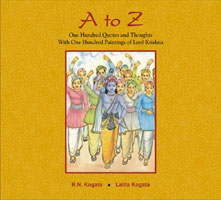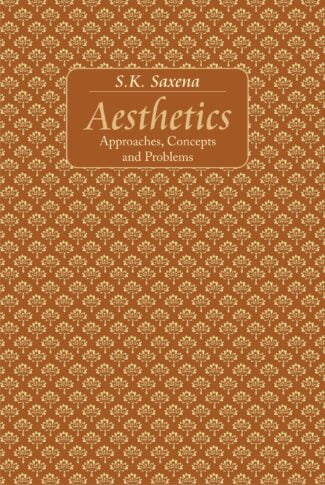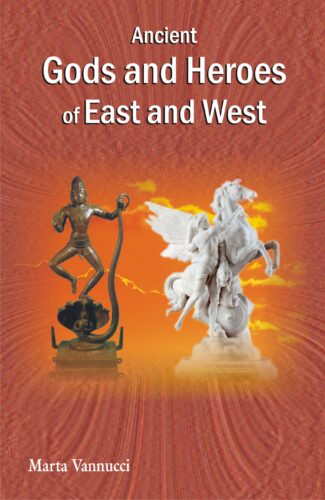Showing 1–10 of 384 results

The 100 inspirational quotations compiled herein speak to the soul, and the thematic art works that are a visual delight, are all about leading a happy, successful life even in the face of odds.
The 100 inspirational quotations compiled herein speak to the soul, and the thematic art works that are a visual delight, are all about leading a happy, successful life even in the face of odds. The quotes become handy in certain situations when one looks around for some advice or encouragement.

The book presents a comprehensive study of Adhyasabhashya in the light of Panchapadika of Padmapada, Bhamati of Vachaspati Mishra, Vivarana of Prakashatma Yati, Ratnaprabha of Govindananda Yati and other Vedantic texts. The commentaries of Brahma-Sutra and Shariraka-Bhashya and definition, causes, types, and results of adhyasa have been analysed in detail.
Adyasavada is the key principle of Advaita Vedanta. Basic premise of this theory is Adhyasabhashya. Before interpreting the first brahmasutra (athat¯o brahmajijnasa (Br.Su. 1.1.1), Acharya Shankara submitted a valuable commentary known as Adhyasabhashya. The book presents a comprehensive study of Adhyasabhashya in the light of Panchapadika of Padmapada, Bhamati of Vacaspati Mishra, Vivarana of Prakashatma Yati, Ratnaprabha of Govindananda Yati and other Vedantic texts. The numerous curiosities associated with Adhyasabhashya have been resolved in the present book: What is the format of Adhyasabhashya? Without commentary on any sutra can Adhyasabhashya be considered as a commentary? Adhyasabhashya begins with sentence yushmadasmatpratyayagocara so Adhyasabhashya consists mangalacharana or not? What is the purpose of Adhyasabhashya?
Adhyasa principle is the cornerstone of Shankaravedanta. This is the theory of error of Shankaravedanta. In the context of theory of error Shankara proposed the theory of Anirvacaniyakhyativada and refuted all prior theories of error. In this book the commentaries of Brahma-Sutra and Shariraka-Bhashya and definition, causes, types, and results of adhyasa have been analysed in detail.
Although it is difficult to write something about complex and difficult theory of Adyasavada, an endeavour is being made to bring out the theory of Adyasavada for scholars through this book.

The book analyses the concepts of Atman, Brahman, and the World, highlighting Sankaras advaitism. In the context of Sankaras philosophy vis-a-vis the Upanisads, it is perhaps the first to explore the meaning and functions of language.
For over a millennium, Shankaras advaitism: non-dualism, has been exposed to extensive discussion, debate, and even polemic. In modern times, it has often been viewed as a system of metaphysical thought, involving a set of several subtle, though interrelated, doctrines which all have the Upanishads at their base. But, wittingly or unwittingly, modern theoreticians/scholars tend to gloss over Shankaras acumen as a philosophical analyst though his interpretations of the Upanishadic writings have indisputably shown his uncommon, rather unrivalled, genius for logic and meticulous philosophical analysis. Professor Ramamurtys work is, thus, a departure from run-of-the-mill studies attempting, as it does, an indepth conceptual analysis of advaita vedanta. The book does not just present advaita as a system of metaphysical thought. It is essentially an off-beat effort seeking to philosophically analyse the concepts of Atman, Brahman, and the World which not only count among the fundamental concepts in the philosophic thought of the Upanishads, but also help capture the true meaning, profoundity, richness and beauty of Shankaras advaita itself. Also, in the specific contexts of Shankaras philosophy vis-a-vis the Upanishadic texts, Professor Ramamurty tries to explore, perhaps for the first time, the meaning and functions of language and the problem that stem from it. Highlighting Shankaras advaitism: his insistence on the oneness of Brahman, the book offers a unique philosophic representation of the Upanishadic vision, which the scholars of classical Indian philosophy and discerning readers would love to share alike.

The book analyses the concepts of Atman, Brahman, and the World, highlighting Sankaras advaitism. In the context of Sankaras philosophy vis-a-vis the Upanisads, it is perhaps the first to explore the meaning and functions of language.
For over a millennium, Shankaras advaitism: non-dualism, has been exposed to extensive discussion, debate, and even polemic. In modern times, it has often been viewed as a system of metaphysical thought, involving a set of several subtle, though interrelated, doctrines which all have the Upanishads at their base. But, wittingly or unwittingly, modern theoreticians/scholars tend to gloss over Shankaras acumen as a philosophical analyst though his interpretations of the Upanishadic writings have indisputably shown his uncommon, rather unrivalled, genius for logic and meticulous philosophical analysis. Professor Ramamurtys work is, thus, a departure from run-of-the-mill studies attempting, as it does, an indepth conceptual analysis of advaita vedanta. The book does not just present advaita as a system of metaphysical thought. It is essentially an off-beat effort seeking to philosophically analyse the concepts of Atman, Brahman, and the World which not only count among the fundamental concepts in the philosophic thought of the Upanishads, but also help capture the true meaning, profoundity, richness and beauty of Shankaras advaita itself. Also, in the specific contexts of Shankaras philosophy vis-a-vis the Upanishadic texts, Professor Ramamurty tries to explore, perhaps for the first time, the meaning and functions of language and the problem that stem from it. Highlighting Shankaras advaitism: his insistence on the oneness of Brahman, the book offers a unique philosophic representation of the Upanishadic vision, which the scholars of classical Indian philosophy and discerning readers would love to share alike.

The book opens with a fairly detailed essay on aesthetics as it is today, and explains the main ways in which contemporary aesthetic thinking is being done, the basic concepts of aesthetics and theories of art. A detailed account of the Indian theory of rasa is also included in the volume.
This work may well be expected to serve as an introduction to the study of aesthetics, suitable alike to the needs of our students and the general reader. A fair part of it deals with some of the more difficult concepts and problems one encounters in contemporary Western philosophical discourse on art. At the same time, the book is studded with illustrative references to contemporary aesthetic practice in India. This is true of almost every individual chapter; and the close is provided by a critical and comprehensive, yet intelligible account of the Indian theory of rasa, to which some eminent Western aestheticians, such as Susanne K. Langer and Harold Osborne, have referred admiringly in some of their basic writings.
What should make this book specially attractive to enquiring readers is its consistent attempt to reflect on teasing aesthetical questions with clarity.

This is decidedly the very first book of its kind. It explains in simple Hindi (or rather Hindustani) the basic concepts and problems of contemporary Western (philosophical) aesthetics with apt illustrative references not only to Hindi (and even Urdu) poetry, but to Hindustani Sangeet and English poetry.
After its attainment of Independence, India has witnessed the quickening of a new life in the field of art as well. Cultural exchanges between its various regions have shown a marked upswing, and reflection on cultural matters has also increased beyond expectations. Concurrently, in quite a few of our colleges and universities aesthetics has been included in the syllabi as an optional subject of study. Some books on this subject, mostly written in the traditional way, are surely available; but philosophical aesthetics, which is today regarded as a distinct intellectual achievement of the twentieth century, still remains largely neglected in the field of Indian scholarship. What is worse, a Hindi book on this form of aesthetics has never been attempted before the present work.
It is precisely this need which this book seeks to meet fairly. With an eye to facilitate understanding of the basic concepts and related problems of contemporary aesthetics, the author has taken pains to give appropriate references, as illustration, to Hindi, Urdu, and English poetry, and music. This should make the book useful to students of both philosophy and music.
Its language is simple Hindustani; and the manner of writing is free from needless ambiguities. Readers in general should therefore find it not only easy to follow, but interesting as well.

This is decidedly the very first book of its kind. It explains in simple Hindi (or rather Hindustani) the basic concepts and problems of contemporary Western (philosophical) aesthetics with apt illustrative references not only to Hindi (and even Urdu) poetry, but to Hindustani Sangeet and English poetry.
After its attainment of Independence, India has witnessed the quickening of a new life in the field of art as well. Cultural exchanges between its various regions have shown a marked upswing, and reflection on cultural matters has also increased beyond expectations. Concurrently, in quite a few of our colleges and universities aesthetics has been included in the syllabi as an optional subject of study. Some books on this subject, mostly written in the traditional way, are surely available; but philosophical aesthetics, which is today regarded as a distinct intellectual achievement of the twentieth century, still remains largely neglected in the field of Indian scholarship. What is worse, a Hindi book on this form of aesthetics has never been attempted before the present work.
It is precisely this need which this book seeks to meet fairly. With an eye to facilitate understanding of the basic concepts and related problems of contemporary aesthetics, the author has taken pains to give appropriate references, as illustration, to Hindi, Urdu, and English poetry, and music. This should make the book useful to students of both philosophy and music.
Its language is simple Hindustani; and the manner of writing is free from needless ambiguities. Readers in general should therefore find it not only easy to follow, but interesting as well.

This critical commentary offering fresh insights into the essential teachings of the Aitareya Upanisad presents its original Sanskrit text along with Roman transliteration and a verse-to-verse translation in English.
Yet another masterly piece of Hindu spiritual wisdom, Aitareya essentially reinforces the grand Upanishadic message which is neither a picturesque mythology nor a promise of heaven nor a threat of hell. It is yet another reminder (from the ancient seers) of our cosmic connection showing how this universe, this phenomenal world of ours, and all that is created, whether movable or immovable, are unfolded from one primeval casual Reality: atman, variantly called the Supreme Spirit, Pure Consciousness or Prajnanam Brahma; and how, in turn, atman perceives itself as the one underlying substance of all these phenomena. A distinguished exponent of Vedanta, Swami Muni Narayana Prasad reinterprets this Upanishad, developing refreshing insights into its textual discourse, its meaning, and its message. Also included in this critical commentary are its original Sanskrit text, Romanised transliteration, and verse for verse English translation. Appended to the Rigveda, Aitareya Upanishad comprises three chapters (IV-VI) of the Aitareya-Aranyaka which, in itself, is a continuation of Aitareya Brahmana. And as one of the principal Upanishads is invaluable as much to the discerning readers as to the scholars of Indian philosophy.

This book is an in-depth study of the people of nomadic groups of Central Asia notably, the Greeks, the ancient Iranians and Indo-Aryans of the Indian subcontinent from about 6000 bce to the last millennium bce. It deals with the evolution of cultures, migrations and settlements, myths and legends gods and heroes of the ancient cultures.
This book is a study of the people of nomadic groups or clans of Central Asia from about 6000 bce to the last millennium bce to explore why cultures and history developed the way they did in Central Asia by taking up the Indo-European and other settlements notably, the Greeks, the ancient Iranians and Indo-aryans of the Indian subcontinent for in-depth study. It deals with the quest for knowledge which led to evolution of cultures from simple primitive life to a society complex in structure, from philosophy to religion. The study of gods and heroes examines stories relating to migration and settlements and the geography of ancient civilizations. It is in this setting that their unique philosophies and religious beliefs flourished, giving rise to belief in numerous gods and heroes. It discusses the myths and legends of the ancient cultures, highlighting names, deeds and events relating to honoured gods and much-praised heroes. Dr Marta Vannucci significantly concludes that both Indo-aryan and Indo-Iranian people had been able to maintain their traditional customs and habits backed by technical developments up to the last centuries bce. Throughout, she bases her observations on reliable information provided by archaeology substantiated by oral and written traditions of Central Asia, Greece and Rome. The volume will be invaluable to scholars of history, anthropology and archaeology who are keen to systematically unravel the obscure origins of the great human civilizational march.

Re-dating and re-interpreting Manusmriti, possibly the oldest law work in the world, the book deals with aspects of Ancient India, including Aryan society and culture, castes and guilds, use of technology and related practices in the Indus Valley Civilisation. It also provides a look at other ancient law codes of the then known world and then compares them with the Manusmriti.
This is a fresh look at the history of Ancient India, centering on the Law Code of Manu (Manusmriti / Manu Dharmashastra), and its relationship to Rigveda and its possible relationship to the Indus/Harappan Civilisation of 4000 to 5000 years ago. It also throws light on Aryan society and culture, castes and guilds, use of technology and related practices in the Indus Valley Civilisation.
Dr. Charles Naegele, a practicing lawyer in Silicon Valley, California, USA, and a lifelong student of classical Indian knowledge, has written a work that will be certain to stir up controversy regarding the re-dating of the Law Code of Manu and the well-documented research concerning almost no possibility of Aryan Invasion Theory and the numerous similarities between the text of the Law Code of Manu and the archeological finds from the Indus/Harappan Civilisation.
Scholars and history buffs, as well as everyone who is proud of Indian heritage will enjoy not only this work, but also his future works.
| There are no products |